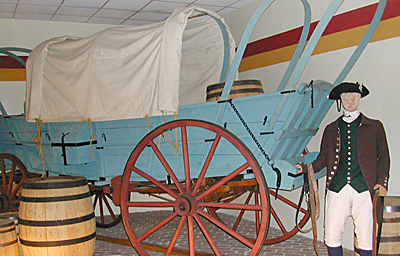 Museum Building
Museum Building
Upon entering the museum, you're greeted with the gift shop, a sitting area, and a old staff car retrieved at the end of WWII. Although I don't recall all the specifics, but the car was in the Phillipines, passed into the hands of the Japanese, then found its way back into US hands.
A covered wagon sits roughly at the start of the history timeline.
Photo of late 19th-early 20th Century wagon (84K)
Turning to the right, you'll follow a roughly chronological timeline of Army transportation from Revolutionary War years to the present. It's a pleasant mix of photos, models, dioramas, uniforms, letters, and actual equipment showing how men and material get moved during wartime.
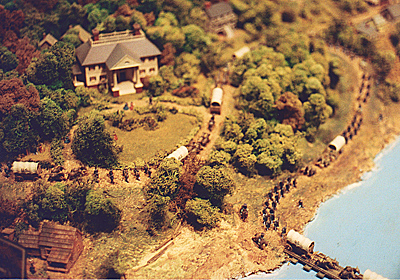 A four-stage diorama, probably 25-feet long, depicted the changes in transportation over the years, from colonial days to mechanized period. The particular shot I took (at right), sadly out of focus in the cramped quarters, was of the American Civil War.
A four-stage diorama, probably 25-feet long, depicted the changes in transportation over the years, from colonial days to mechanized period. The particular shot I took (at right), sadly out of focus in the cramped quarters, was of the American Civil War.
Towards the back of the building is a long display with a Conestoga Wagon, and WWI Liberty truck.
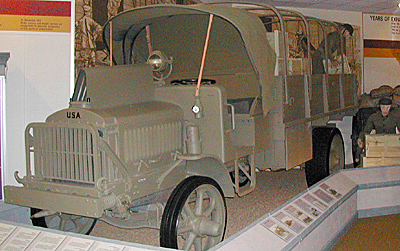 The WWI Liberty truck was a standardized design. I guess you could have any color you wanted as long as it was olive drab. Of note were the letters home sent by one of the drivers, marvelling at the carrying capacity and general toughness of the vehicle, as well as some of the horrendous conditions they were forced to drive in. Some cargo is mentioned as well.
The WWI Liberty truck was a standardized design. I guess you could have any color you wanted as long as it was olive drab. Of note were the letters home sent by one of the drivers, marvelling at the carrying capacity and general toughness of the vehicle, as well as some of the horrendous conditions they were forced to drive in. Some cargo is mentioned as well.
WWI Liberty truck. The text on the display just in front of the bumper contains the letters home of one of the young drivers hauling cargo around the US.
Photo of WWI uniform and driver recruiting poster (120K)
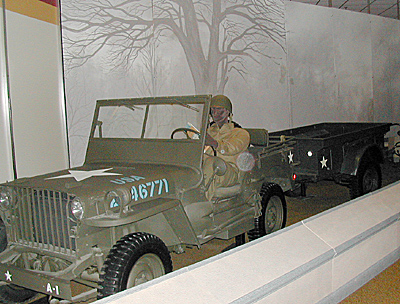 The next exhibit features a jeep and truck from the WWII Red Ball Express, which delivered supplies across France after D-Day.
The next exhibit features a jeep and truck from the WWII Red Ball Express, which delivered supplies across France after D-Day.
At right, a jeep and trailer on display.
Up next was Korea, followed by Vietnam.
Photo of Korean War helicopter (162K)
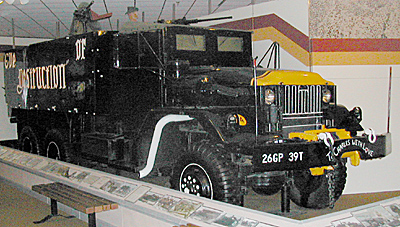 Of note is the rare "Eve of Destruction," a five-ton armor plated cargo truck armed with a couple of 50-caliber machine guns. It was used for convoy duty along various Vietnam highways.
Of note is the rare "Eve of Destruction," a five-ton armor plated cargo truck armed with a couple of 50-caliber machine guns. It was used for convoy duty along various Vietnam highways.
In cramped quarters, the Eve of Destruction from the Vietnam War. The slogan painted on the front bumper reads "To Charles with Love."
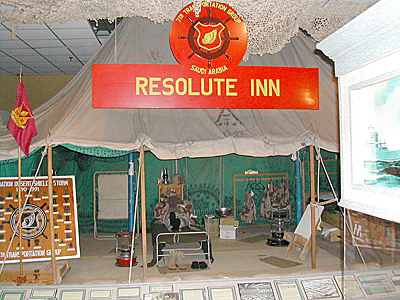 Moving into the Gulf War area, a supply headquarters tent, HUMMV, manikin, and various equipment show a life-sized diorama.
Moving into the Gulf War area, a supply headquarters tent, HUMMV, manikin, and various equipment show a life-sized diorama.
Part of the Gulf War display.
Displayed under cover near the Rail Yard
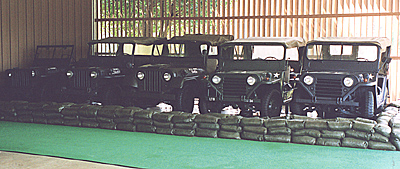 Exiting out the side doors, you come to a covered patio showing the development of the Jeep from WWII to the Cold War with a display of five jeeps.
Exiting out the side doors, you come to a covered patio showing the development of the Jeep from WWII to the Cold War with a display of five jeeps.
According to the brochure, although I cannot remember exactly what vehicles were in the patio, also displayed:
DUKW-353 Responding to a request for a "truck that can swim," GMC developed the amphibious 2-lh ton, 6x6 truck in 1942. It was a design success, taking only 38 days from mock-up to prototype. Weighing 5,000 lbs empty, it normally carried a 2,400-lb payload. Powered by a 6-cylinder engine, the DUKW traveled 50 mph on land and 6 knots in water. Active in its development, the Transportation Corps became responsible all amphibious training and maintenance at Fort Story in January 1943.
TRUCK TRACTOR, 5-ton, 4x2 The commercial International DCO 205-H tractors were introduced to the 37th Transportation Group, US Army Europe in 1965 for line haul missions, saving wear and tear on tactical vehicles. Powered by a Model C-160 Cummins diesel 6-cylinder engine with 160hp, the 205's averaged 25,000 miles per year. This vehicle was retired with over 120,000 miles of line haul service throughout Europe.
WRECKER, M-969A, 4-TON, 6x6 Adopted by the US Army in 1939, this heavy wrecker was used during WW II in the European Theater of Operations. A total of 6,429 were manufactured by Diamond-T between 1940-1945. Designed with metal cab and a Holmes W-45 wrecker body, it was initially powered by a 529 cubic inch Hercules Model RXC engine, and later fitted with a 6cylinder Continental engine. The heavy-duty booms can be operated off the rear or either side. A 15,000-lb capacity Garwood Industries PTO winch (power train operated) is mounted on front. The 5-speed transmission allowed a 40 mph governed speed, and a cruising range of 250 miles.
Not in the Brochure, but there anyway:
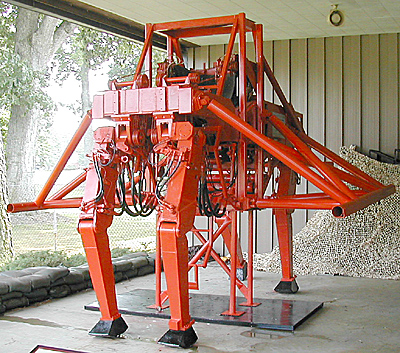 The patio also holds an orange monstrosity that the brochure calls a "truck that walks" and a "cybernetic walking machine." Too bad it doesn't run (literally or figuratively)--I'd bet folks would like to see the thing walk for the sheer novelty of it. I can't imagine it can go very fast, but it's not like this prototype is practical. I suppose you have to start somewhere.
The patio also holds an orange monstrosity that the brochure calls a "truck that walks" and a "cybernetic walking machine." Too bad it doesn't run (literally or figuratively)--I'd bet folks would like to see the thing walk for the sheer novelty of it. I can't imagine it can go very fast, but it's not like this prototype is practical. I suppose you have to start somewhere.
Beyond this patio lies the Railroad Park.
More Fort Eustus US Army Transportation Museum
- Introduction
Museum Building
Railroad Park
Cargo Handling Yard
Aviation Pavilion
Marine Park
Summary
Back to List of Historic Sites
Back to Travel Master List
Back to MagWeb Master List of Magazines
© Copyright 2003 by Coalition Web, Inc.
This article appears in MagWeb (Magazine Web) on the Internet World Wide Web.
Other articles covering military history and related topics are available at http://www.magweb.com